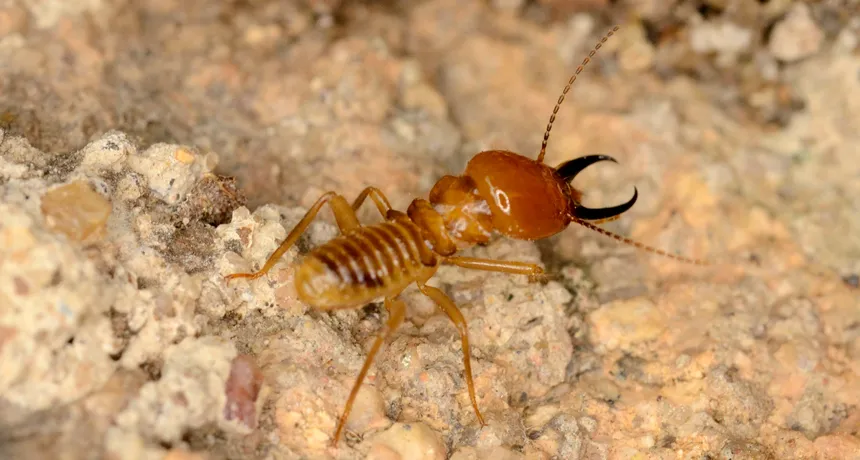
DEFENDER A soldier termite stands ready to headbang an alarm and use its superbly sensitive legs to catch clues about which way to run to defend itscolony against a predator.
Christoph Bosch
A soldier termite can tell which way to run in a crisis by sensing SOS-message time delays — only hundredths of a human eyeblink long — with its feet.
Africa’s Macrotermes natalensis termite relies on a fighter caste to defend its hardened, meter-high-plus mounds and up to several thousand square meters of underground tunnels. When an aardvark or other predator gouges the insects’ home, termites known as major soldiers pound their heads against the floors. The vibrations from the drumbeat tell other soldiers to speed to the breach.
These headbanger alarms vibrate through the walls of tunnels at about 130 meters per second. What lets a soldier know which direction to go are the slight delays in the vibrations traveling from the soldier’s leg nearest the drumbeat source to its farthest leg, says Felix Hager of Ruhr University Bochum in Germany. A delay of as little as 0.20 milliseconds was enough to orient soldiers in a lab setup, Hager and Ruhr colleague Wolfgang Kirchner report July 15 in the Journal of Experimental Biology.

Research on the communicative power of beats, shivers and tickles vibrating through solid surfaces lags far behind the study of airborne sounds, says Peggy S.M. Hill of the University of Tulsa in Oklahoma, who has long studied insect vibrations. Textbooks of the mid-1970s insisted that natural solids like soil or twigs were, she says, “not suitable for transmitting any biologically meaningful information via vibrations.” Not true, she adds, as growing evidence shows.
Researchers now estimate that some 150,000 insect species communicate only by vibrations drummed through their nests, the ground, plants or some other solid surface, Hager says. “We are just beginning to understand how they do it.”
In 2013, Hager and Kirchner showed that soldier termites that hear a headbanging alarm start headbanging too, sending the message farther through the termite empire than a single transmission would go. To see how those vibrations draw soldiers in the right direction, the researchers placed termites on a plastic platform with two sides separated by a 1-millimeter gap. When a soldier had its right legs on one side of the gap and its left legs on the other, a researcher triggered vibrations in the platform so that one side started shaking just a smidge earlier than the other side.
When delays lasted 0.20 milliseconds, the termites showed a clear preference for turning toward or moving onto the first-to-shake platform side. Lengthening the delay another 0.09 milliseconds caused an even more decisive reaction.
Termite performance in the lab shows that the insects can detect delays of the order of magnitude they would need to make sense of an alarm in the wild, Hager says. He calculates that a major soldier (the larger of two size classes of soldiers) in a real tunnel would experience a vibrations gap of about 0.12 milliseconds between the time a headbanging signal buzzed the first front leg and the time it reached the rearmost one on the opposite side, a distance of about 16 millimeters.
Other research has already shown that insect nervous systems handle even briefer delays in airborne vibrations — 0.01 milliseconds for locusts — as sound hits first one ear and then the next. People also detect the direction of sound vibrations by picking up the kinds of tiny delays that insects use, Kirchner notes. “They’re as good as we are.”






